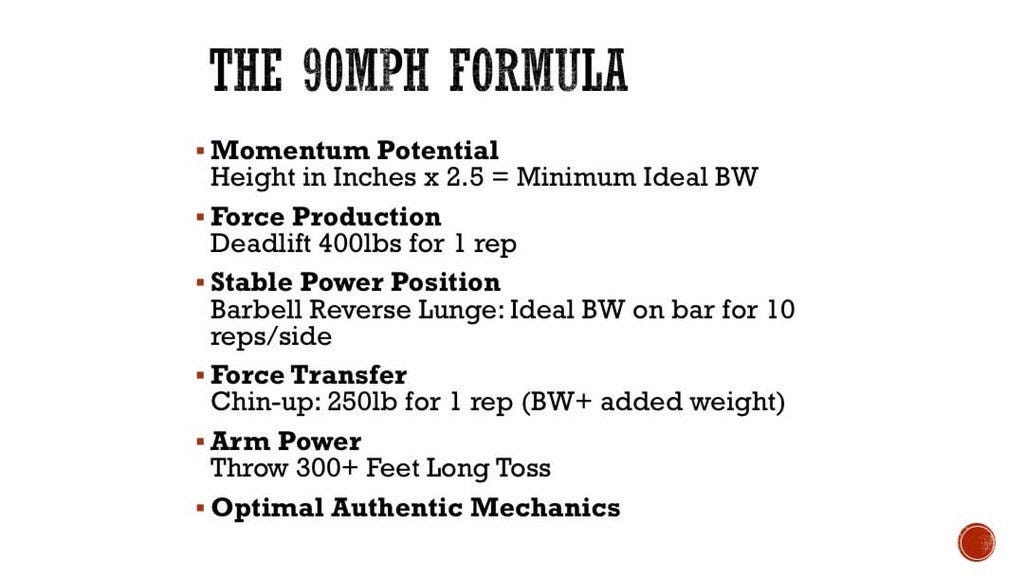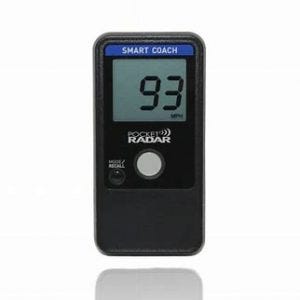Throwing Program MUSTS
To help parents, coaches, and athletes in their quest to become the best players they or their child can be, I wanted to provide a basic outline of the best throwing programs I’ve seen that incorporate the necessary elements to achieve results. This isn't a fully comprehensive list, but if you are considering training somewhere or with someone that lacks one or more of the following, I would strongly advise reconsideration. So, without further ado, here is my list of what a throwing program NEEDS to have:
Assessment/Reassessment Process
Any program worth its salt should include a movement screen (FMS/FCS, TPI, etc.), range of motion assessment, strength assessment, and video analysis. The coach or program needs to understand potential physical limitations (or exceptional capabilities, such as hypermobility), as well as the strengths and weaknesses of each athlete to determine where to begin programming. If a trainer or coach doesn't appreciate an athlete's movement profile, skeletal structure, injury history, etc., it's only a matter of time before injuries happen. A vast majority of injuries that occur during training can be prevented. Making informed decisions about which exercises or drills an athlete should or shouldn't be doing is an absolute must. If your current training location doesn’t assess AND reassess its clients, consider looking elsewhere. Being able to evaluate improvements and making informed decisions about where to alter programming to minimize risks is crucial. This brings me to the next point...
Individualized Programming
Individualized programming for baseball pitchers is paramount due to the inherent uniqueness of each athlete. No two players share identical strengths, weaknesses, lever lengths, training histories, or genetic makeups. Consider the scenario of providing a standardized program to both a 17-year-old with five years of weightlifting experience and above-average throwing velocity, and a 13-year-old novice struggling to break a plane of glass with their fastball. Such an approach is not only impractical but also borders on incompetence. Acknowledging and addressing the distinctive attributes of each pitcher is crucial for their development, especially the higher the training age and ability. Tailoring throwing and training programs to align with individual goals and areas requiring improvement is the hallmark of a successful coach. Without this personalized approach, a program risks falling short of its potential, leaving potential progress on the table.
On-ramp period
The on-ramping of a baseball pitcher's throwing workload is not just a suggestion; it is an absolute necessity. Incorporating a structured period of time dedicated to gradually building up to high-intensity throwing, including pulldowns and/or bullpen sessions, is crucial. This process is akin to laying a foundation for a structure; without it, the risk of an arm injury skyrockets.
The SAID Principle, or Specific Adaptation to Imposed Demands, holds particular significance in this context. Throwing at high intensities imposes unique stresses on the arm, and the body requires adequate time to adapt to these increased demands. Rushing this process, under the principle of "too much, too soon," is a recipe for disaster. It not only undermines the potential for optimal performance but significantly heightens the risk of injuries that could have been preventable with a more gradual and thoughtful approach.
In essence, the careful on-ramping of throwing workload serves as a protective measure, aligning with the body's natural adaptation processes. By acknowledging the need for a systematic buildup, coaches and pitchers can establish a foundation for sustained success while mitigating the potential for debilitating injuries.
A Strength & Conditioning Program
Increasing throwing velocity, improving mechanics, improving command, ensuring arm health isn’t all on the pitching coach. There NEEDS to be a strength training component as well. These two programs should work in unison with one another to correct movement and strength deficiencies.
The unique physical demands placed on pitchers, especially in terms of arm strength, endurance, and overall athleticism, necessitate a targeted approach to training. Strength training plays a pivotal role in enhancing a pitcher’s power and stability, providing a solid foundation for pitching mechanics.
All of your programming should be based off that initial assessment discussed earlier. Find your lowest hanging fruit, be it strength, power, or movement quality, and attack it relentlessly. If you’re doing a high-intensity throwing program without adding strength, power, and correcting movement flaws in the weight room, you’re begging for a disaster. Arm care isn’t just managing throwing workload. Being able to recover physically and improve sport-specific skills all comes down to how well one trains in the weight room. Want to know what correlates extremely well with throwing velocity? Strength. Get in the weight room. Want more info on this? I’ll refer you to the experts I trust on twitter that are way better in this arena than myself (Tommy Johnson, Nunzio Signore, Austin Wasserman, Zach Dechant, Eric Cressey and Josh Heenan).
A Proper Warm Up and Recovery Protocol
Often the most overlooked aspects of any throwing program are a proper full-body, as well as arm-specific, warm-up, and recovery routine. When looking at the best players in the world, they all have a pregame and postgame routine to prepare for the next task, whether it's getting ready to pitch or jumpstarting the recovery process. It's an important piece of the puzzle that often separates the average from those who advance in this game. Coaches may have varying opinions on this, but finding a routine that works for YOU and is repeatable/sustainable regardless of the environment or context is crucial. There's no use getting used to equipment you only have in a facility when it's not in your bullpen. That process can be different for everyone. Some get loose with skips and arm circles, while others need more targeted focus. Experiment and explore what works best for YOU. If you need some help in this area, check out these resources: BR Warmup and WB Warmup.
Radar Gun
Any throwing program is incomplete without a radar gun. Not getting regular velocity checkups to see if any progress/regression is occurring is suboptimal from a training perspective. The best part about the radar gun is its blunt objectivity. There's no emotion involved; it's just pure feedback. Having instant feedback to know if a different cue or mechanical thought worked or didn't is invaluable. The radar gun can also be a quality way to monitor intent. Yes, getting feedback on max intent throwing is important, but having feedback on sub-max throwing days to monitor intensity can provide value as well. Ben Brewster talks about the idea of “throwing hard easy” here while using the radar gun as feedback on a recovery day. No radar gun? Not a real program."
Client Education and Culture
Lastly, any throwing program should include clients learning about the task. That doesn’t mean every athlete needs to understand the throwing motion as well as the best coaches in the world, but they do need to comprehend what makes them successful and how/what to adjust to get themselves back on track when failure inevitably occurs. A pitching coach’s ultimate job is to no longer be needed. A great college pitching coach once told me his ultimate goal is to be able to sit in a lawn chair at practice because all of his pitchers know what they need to do and how to get better. That being said, this works best in an environment where everyone wants to work their tail off to improve. A great program doesn’t mean much if you aren’t training in the right environment. If the other people you’re working with aren’t rooting for you to succeed, you’re at the wrong place. Being in a (healthy) competitive training culture is what truly makes a program great. I’m willing to wager at least 70% of facilities and organizations have most, if not all, of what I previously discussed. But what separates the good from the great? The training environment.
Thank you for reading this far. I hope you learned something. Did I miss something? Do you disagree with my list? Let me know!
Be sure to follow me on twitter and Instagram at @PitchMechanics and feel free to reach out with any questions! Video analysis available, if interested. Email pitchingmechanicstips@gmail.com with any questions!



